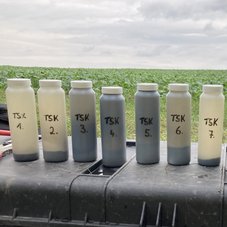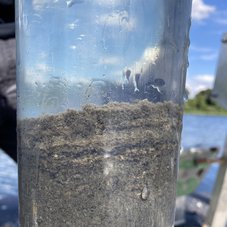Environmental Changes and Paleoclimate – A Long-Term Study at Lake Tiefer See | TERENO Northeast
The sensitivity of lakes to changes in environmental conditions makes them excellent hydroclimatic archives. However, the transmission of environmental signals into the lacustrine record is very complex and involves different hydroclimatic-limnological-sedimentological processes on different time scales. In order to distinguish and quantify the signal transmission processes in lakes, we have installed and continuously developed a long-term, intensive meteorological-limnological-sedimentological monitoring system at the Tiefer See near Klocksin in northeastern Germany as part of the TERENO Northeast Observatory since 2012.
Motivation and objectives
- a better understanding of seasonal sedimentation processes and the factors controlling them (climatic conditions, environmental changes and human impacts)
- to observe the regional and local effects of ongoing global change on the lake
- to use the understanding gained through monitoring to enable the interpretation of proxy data from sediment archives for more reliable climate reconstructions and thus to provide basic palaeoclimate data for improved climate modelling
Why Lake Tiefer See?
We work at Lake Tiefer See because both in the geological past (since the last ice age) and at present, seasonally stratified lake sediments (varves) are deposited. Varves allow us a detailed insight into seasonal sedimentation processes of the past and the creation of chronologies that are accurate to the year. Monitoring in the Lake Tiefer See provides us with recent seasonal information on the factors that determine sediment deposition. These factors are fundamental for a palaeoclimatic interpretation and the reconstruction of environmental conditions, including the interactions between humans, climate and environment.

Lake Tiefer See is located in the north-eastern part of the Natural Park Nossentiner-Schwinzer Heide. With a maximum depth of 62.5 metres, it is the deepest lake in the Klocksiner lake chain, which was created as a subglacial channel during the last glaciation. The lake is located near the Pomeranian ice margin (W2 moraine), which was deposited by the Scandinavian inland ice during the last ice age. The catchment area of the Lake Tiefer See was formed by glacial processes and the glacial deposits are characterised by boulders. After the glaciers melted, the lake basin was filled with dead ice for several thousand years until the formation of Lake Tiefer See in late Allerød, around 13,000 years ago. The initial lake deposits that we find in sediment cores are meltwater sands. The deposition of organic sediments began abruptly with the warming at the beginning of the Holocene 11,600 years ago.
Structure and organisation of monitoring
The monitoring includes (1) a permanent weather station on the lake, (2) lake water observation, (3) sediment traps and (4) regular sampling of surface sediment cores from different parts of the lake basin.
Uniquely in TERENO, we have the possibility to transfer the results of the monitoring directly to the terrestrial palaeoclimate lake sediment core archive deposited in the lake. The lake sediment cores required for this were and are drilled by us as part of TERENO.



(1) The weather station is mounted on a floating platform that is permanently anchored at the deepest point of the lake basin. We measure air temperature, air pressure, precipitation amount, global radiation, photosynthetically active radiation (PAR), wind direction and wind speed every 10 minutes. Precipitation water collectors and dust collectors are also installed on the platform. δD and δ18O isotope analyses of the precipitation water are carried out from the Stable Isotope Laboratory for Sediments and Water at monthly intervals.
(2) Lake water monitoring: two parallel automatic water probes measure water temperature, pH value, conductivity, turbidity, oxygen content, redox potential and chlorophyll every 12 hours at 1 metre intervals up to a water depth of 55 metres. In addition, permanent loggers are installed for temperature measurements every 6 hours at 1 metre intervals up to a water depth of 15 metres and at 5 metre intervals up to a water depth of 55 metres. The Secchi depth is measured manually at monthly intervals, water samples are taken for δD and δ18O analyses at depths of 1, 3, 5, 7, 10, 20, 40, 45, 50 and 55 m and solid particles are filtered from water samples taken at depths of 1, 3, 5, 7, 10, 20, 50 and 55 m. Lake level loggers are installed at the edge of the reed belt to the open lake for daily measurement of the lake level.
(3) Sediment traps: two different types of sediment traps are installed at different water depths. The traps collect the particles sinking in the water column at different temporal resolutions. A sequential trap at a water depth of 50 metres collects sediments at 15-day intervals. Two 4-cylinder traps at a water depth of 12 and 50 metres collect sediments at monthly intervals. From the sediment samples from all traps we determine in the laboratory total carbon (TC), total nitrogen (TN), calcium carbonate content (CaCO3) and the isotope ratios δ13Corg, δ15N, δ13Ccarb and δ18Ocarb.
(4) Short cores: every year, short surface lake sediment cores are taken from different parts of the lake basin and then analysed geochemically in the laboratory, in order to link the high-resolution monitoring data currently obtained with the long lake sediment climate archives of the past and to gain insights for a better understanding of the sedimentation processes and the factors controlling them.
- Sirota, I., Tjallingii, R., Pinkerneil, S., Schroeder, B., Albert, M., Kearney, R., Heiri, O., Breu, S., and Brauer, A. (2024): Tracing rate and extent of human-induced hypoxia during the last 200 years in the mesotrophic lake, Tiefer See (NE Germany), Biogeosciences, 21, 4317–4339. https://doi.org/10.5194/bg-21-4317-2024
- Nwosu, E. C., Brauer, A., Monchamp, M.-E., Pinkerneil, S., Bartholomäus, A., Theuerkauf, M., Schmidt, J.-P., Stoof-Leichsenring, K. R., Wietelmann, T., Kaiser, J., Wagner, D., Liebner, S. (2023): Early human impact on lake cyanobacteria revealed by a Holocene record of sedimentary ancient DNA. - Communications Biology, 6, 72. https://doi.org/10.1038/s42003-023-04430-z
- Brauer, A., Heinrich, I., Schwab, M. J., Plessen, B., Brademann, B., Köppl, M., Pinkerneil, S., Balanzategui, D., Helle, G., Blume, T. (2022): Lakes and trees as climate and environment archives: the TERENO Northeastern German Lowland Observatory. - DEUQUA Special Publications, 4, 41-58. https://doi.org/10.5194/deuquasp-4-41-2022
- Brauer, A., Schwab, M. J. (2022): Preface: Quaternary landscapes, sediments and geoarchives in northeastern Germany – a guidebook to field excursions. - DEUQUA Special Publications, 4, 1-3. https://doi.org/10.5194/deuquasp-4-1-2022
- Nwosu, E.C., Brauer, A., Kaiser, J., Horn, F., Wagner, D., Liebner, S. (2021a). Evaluating sedimentary DNA for tracing changes in cyanobacteria dynamics from sediments spanning the last 350 years of Lake Tiefer See, NE Germany. Journal of Paleolimnology, 66: 279–296. https://doi.org/10.1007/s10933-021-00206-9
- Nwosu, E.C., Roeser, P., Yang, S., Ganzert, L., Dellwig, O., Pinkerneil, S., Brauer, A., Dittmann, E., Wagner, D., Liebner, S. (2021b). From Water into Sediment – Tracing Freshwatrer Cyanobacteria via DNA Analyses. Microorganisms, 9: 1778. https://doi.org/10.3390/microorganisms9081778
- Nwosu, E.C., Roeser, P., Yang, S., Pinkerneil, S. Dittmann, E., Brauer, A., Wagner, D., Liebner, S. (2021c). Species-Level Spatio-Temporal Dynamics of Cyanobacteria in a Hard-Water Temperate Lake in the Southern Baltics. Front. Microbiol., 12:761259. https://doi.org/10.3389/fmicb.2021.761259
- Theuerkauf, M., Blume, T., Brauer, A., Dräger, N., Feldens, P., Kaiser, K., Kappler, C., Kästner, F., Lorenz, S., Schult, M. (2021) Holocene lake-level evolution of Lake Tiefer See, NE Germany, caused by climate and land cover changes. Boreas. ISSN 0300-9483. https://doi.org/10.1111/bor.12561
- Roeser, P., Dräger, N., Brykała, D., Ott, F., Pinkerneil, S., Gierszewski, P., Lindemann, C., Plessen, B., Brademann, B., Kaszubski, M., Fojutowski, M., Schwab, M.J., Słowiński, M., Błaszkiewicz, M., Brauer, A. (2021). Advances in understanding formation of calcite varves: new insights from a dual lake monitoring approach. Boreas. https://doi.org/10.1111/bor.12506
- Roeser, P., Dräger, N., Brykała, D., Ott, F., Pinkerneil, S., Gierszewski, P., Lindemann, C., Plessen, B., Brademann, B., Kaszubski, M., Fojutowski, M., Schwab, M. J., Słowiński, M., Błaszkiewicz, M., Brauer, A. (2021): TERENO Monitoring data from Lake Tiefer See and Lake Czechowskie (2012-2017). https://doi.org/10.5880/GFZ.4.3.2020.003
- Nantke, C.K.M., Brauer, A., Frings, P.J., Czymzik, M., Hübener, T., Stadmark, J., Dellwig, O., Roeser, P., Conley, D.J. (2021). Human influence on the continental Si budget during the last 4300 years: δ30Sidiatom in varved lake sediments (Tiefer See, NE Germany). Quarternary Science Reviews 258: 106869. https://doi.org/10.1016/j.quascirev.2021.106869
- Brauer, A., Tiedemann, R. (2021): GEOfokus: See- und Ozeansedimente in der Paläoklimaforschung. - GMIT - Geowissenschaftliche Mitteilungen, 83, 7-22. https://doi.org/10.23689/fidgeo-3995
- Dräger, N., Plessen, B., Kienel, U., Słowiński, M., Ramisch, A., Pinkerneil, S., Brauer, A. (2019). Relation of δ13C of sedimentary organic matter and varve preservation in the sediment record of Lake Tiefer See (NE Germany). Journal of Paleolimnology, 62:181–194. https://doi.org/10.1007/s10933-019-00084-2
- Brauer, A., Schwab, M. J., Brademann, B., Pinkerneil, S., Theuerkauf, M. (2019): Tiefer See – a key site for lake sediment research in NE Germany. - DEUQUA Special Publications, 2, 89-93. https://doi.org/10.5194/deuquasp-2-89-2019
- Czymzik, M., Muscheler, R., Adolphi, F., Mekhaldi, F., Dräger, N., Ott, F., Słowinski, M., Błaszkiewicz, M., Aldahan, A., Possnert, G., Brauer, A. (2018). Synchronizing 10Be in two varved lake sediment records to IntCal13 14C during three grand solar minima. Clim. Past, 14, 687–696. https://doi.org/10.5194/cp-14-687-2018
- Heinrich, I., Balanzategui, D., Bens, O., Blasch, G., Blume, T., Böttcher, F., Borg, E., Brademann, B., Brauer, A., Conrad, C., Dietze, E., Dräger, N., Fiener, P., Gerke, H.H., Güntner, A., Heine, I., Helle, G., Herbrich, M., Harfenmeister, M., Heußner, K.-U., Hohmann, C., Itzerott, S., Jurasinski, G., Kaiser, K., Kappler, C., Koebsch, F., Liebner, S., Lischeid, G., Merz, B., Missling, K.D., Morgner, M., Pinkerneil, S., Plessen, B., Raab, T., Ruhtz, T., Sachs, T., Sommer, M., Spengler, D., Stender, V., Stüve, P., Wilken, F. (2018). Interdisciplinary Geo-ecological Research across Time Scales in the Northeast German Lowland Observatory (TERENO-NE). Vadose Zone Journal. https://doi.org/10.2136/vzj2018.06.0116
- Kienel, U., Kirillin, G., Brademann, B., Plessen, B., Lampe, R., Brauer, A., (2017). Effects of spring warming and mixing duration on diatom deposition in the deep Tiefer See, NE Germany. Journal of Paleolimnology 57, 37–49. https://doi.org/10.1007/s10933-016-9925-z
- Dräger, N., Theuerkauf, M., Szeroczynska, K., Wulf, S., Tjallingii, R., Plessen, B., Kienel, U., Brauer, A. (2017): Varve microfacies and varve preservation record of climate change and human impact for the last 6000 years at Lake Tiefer See (NE Germany). - Holocene, 27, 3, 450-464. https://doi.org/10.1177/0959683616660173
- Heine, I., Brauer, A., Heim, B., Itzerott, S., Kasprzak, P., Kienel, U., Kleinschmit, B. (2017). Monitoring of calcite precipitation in hardwater lakes with multi-spectral remote sensing archives. Open Access Journal Water 9, 15. https://doi.org/10.3390/w9010015
- Szeroczyńska, K. (2016): Long term subfossil Cladocera record from the partly varved sediment of Lake Tiefer See (NE Germany). Advances in Oceanography and Limnology, 7(2). https://doi:10.4081/aiol.2016.6297
- Wulf, S., Dräger, N., Ott, F., Serb, J., Appelt, O., Guðmundsdóttir, E., van den Bogaard, C., Słowiński, M., Błaszkiewicz, M., Brauer, A. (2016): Holocene tephrostratigraphy of varved sediment records from Lakes Tiefer See (NE Germany) and Czechowskie (N Poland). - Quaternary Science Reviews, 132, 1-14. https://doi.org/10.1016/j.quascirev.2015.11.007
- Czymzik, M., Muscheler, R., Brauer, A., Adolphi, F., Ott, F., Kienel, U., Dräger, N., Słowiński, M., Aldahan, A., Possnert, G. (2015). Solar cycles and depositional processes in annual 10Be from two varved lake sediment records. Earth and Planetary Science Letters 428, 44-51. https://doi.org/10.1594/PANGAEA.848364
- Theuerkauf, M., Dräger, N., Kienel, U., Kuparinen, A., Brauer, A. (2015): Effects of changes in land management practices on pollen productivity of open vegetation during the last century derived from varved lake sediments. - Holocene, 25, 5, 733-744. https://doi.org/10.1177/0959683614567881
- Kienel, U.; Dulski, P.; Ott, F.; Lorenz, S.; Brauer, A. (2013): Recently induced anoxia leading to the preservation of seasonal laminae in two NE-German lakes. Journal of Paleolimnology, 50/4, 535-544. https://doi.org/10.1007/s10933-013-9745-3
